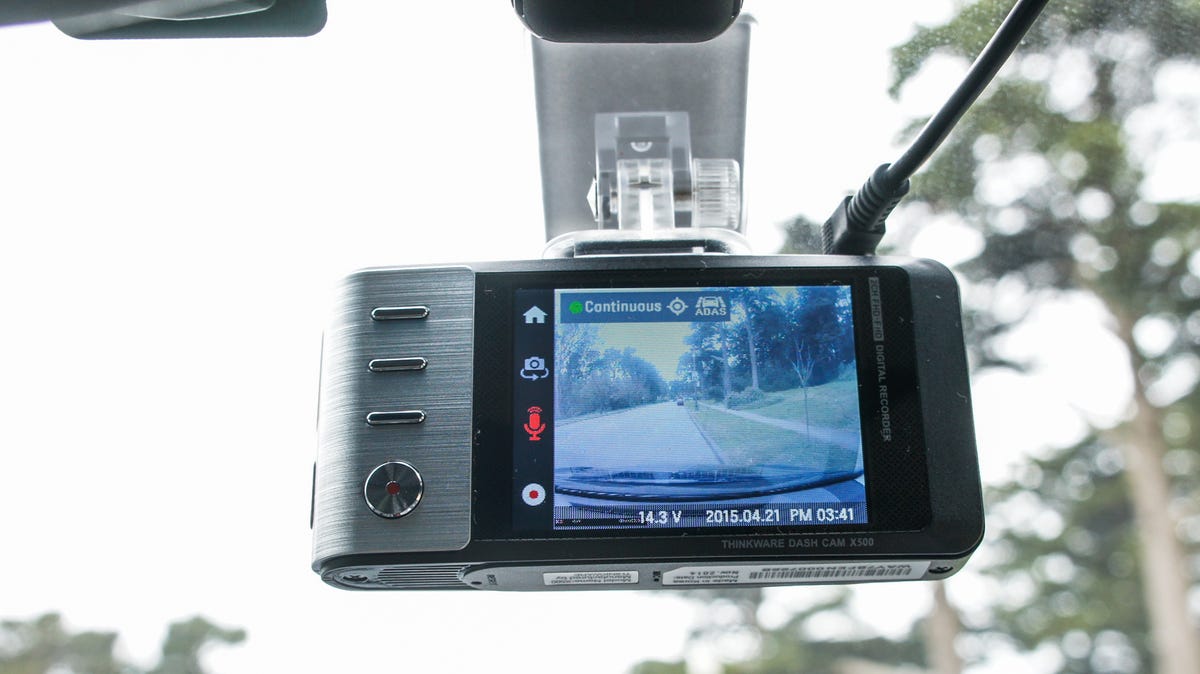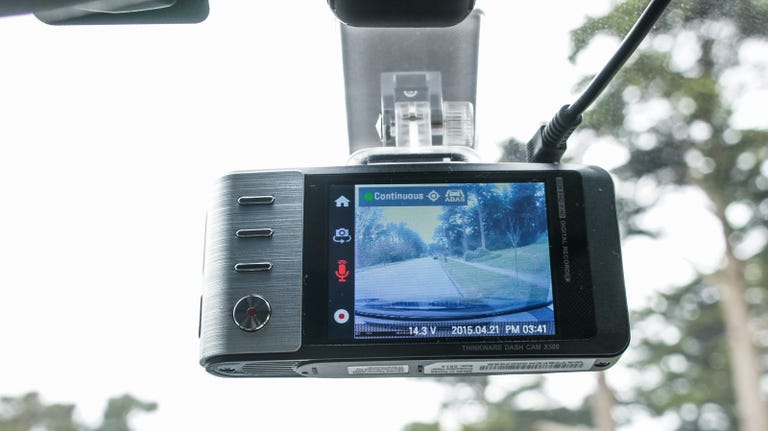 Why You Can Trust CNET
Why You Can Trust CNET Thinkware Dash Cam X500 review: Thinkware Dash Cam X500 records collisions, warns of speed cameras
Going above and beyond simple incident recording, the Thinkware Dash Cam X500 uses its camera to give drivers forward collision alerts and its GPS to warn of speed cameras.
Dashboard cameras, which continuously record driving video, are nothing new, but Thinkware puts a new twist on the technology with its Dash Cam X500, using the camera to add driver assistance features and its GPS to warn of speed or red-light cameras.
The Good
The Bad
The Bottom Line
The Thinkware Dash Cam X500 goes for $279 in the US and £199 in the UK, where speed zones and cameras would make it more useful. Australian pricing was not available, but the company does have an Australian distributor.
The Dash Cam X500 attaches to the windshield, near the rearview mirror, and automatically begins recording whenever you start the car. An accelerometer senses impact, causing the X500 to save video of a collision, which can later be used as evidence in legal proceedings.
At 4.1 inches long and 2 inches high, and with its camera lens, the X500 resembles a pocket-size digital camera. Lending to that resemblance is the LCD dominating the back of the device. Four buttons are stacked next to the LCD, and the top of the X500 features a power port and two connector ports designed for the X500's accessories. The X500 saves its video to a microSD card in the side of the device and its own internal storage.

A plastic attachment point on top of the X500 lets you slide it onto the included mounting bracket.
Although the X500 lacks a touchscreen, I found it easy to navigate its onscreen menus using the four buttons on its back. The two center buttons scroll through feature lists, while the top and bottom buttons let me go back or select features.
In addition, Thinkware includes file viewer software that works on Windows or Apple OS. This viewer shows video windows for front and rear video, along with a map window showing the car's location during recording, vehicle speed and even pitch, yaw, and roll angles.
Although most of the viewer software looks fine, the file chooser is very rough. A window shows all the video files created by the X500, separated into categories for Continuous, Motion, Event and Manual. The problem here is that, even for a short drive, the X500 creates a lot of video files. The file names include the date and time in a string, which can be difficult to visually parse. It would be better if the viewer software parsed the file information for time and location, then gave users a better interface for finding relevant video clips.
Record and drive
To test the X500, I installed it in a 2015 Toyota Camry. The plastic mounting bracket includes an adhesive pad that sticks to the inside of the windshield. Make sure to get that bracket precisely where you want it, as the adhesive pad is very difficult to remove. Putting it just in front of the rearview mirror kept it from blocking my view of the road, but I had to run its power cable over the sun visor, down the side of the car, then back over to the console to reach the 12-volt power point.
The included power cable is long enough to run through a car, but it would be more convenient if Thinkware used a USB plug rather than the cable's fixed 12-volt adapter, which monopolizes an entire power point in a car.
As soon as I turned on the car, the X500 turned on, and its female voice prompt told me continuous recording had begun. In later testing I found that it won't run without the microSD card inserted in its slot. Thinkware includes a 16MB card with a full-size SD card adapter in the package.
I headed out onto he street, the X500 working unobtrusively in the background, until its forward camera thought I was about to hit someone or I approached an intersection with a red-light camera. While I drove, the X500 periodically beeped at me, leaving me to interpret what that beep might mean. I had its forward collision alert and lane departure warning enabled, and it would also beep when it recorded an impact event. Although I never actually collided with another car, the X500 saved almost 20 Event videos over about a 40-minute drive.
Even with the sensitivity set to its second-lowest level, it didn't take much to trigger the X500's Event recording. If I had turned off the device's beep alert for these Events, it wouldn't have been as annoying.
For each triggered Event, the X500 saved the previous and post-Event 10 seconds of video. If I had been in an accident, that amount of time would be enough to show what happened within the camera's field of view. The camera shows a very wide angle, but won't show if someone hits you from the side. Thinkware offers an optional rearview camera, fully integrated with the X500, that can show what happened behind your car in a triggered Event. The X500 not only saves Event video to the microSD card, but can also be set to save this video to internal memory, backing it up in case the card fails.
Driver assistance
As for the driver assistance features, the X500 also shows a visual alert on its LCD, but as I had the device mounted behind the rearview mirror, its LCD was out of my view. While a forward collision alert can be useful, I noted the system wasn't very refined in what it thought was an object in its path. Approaching a hill, for example, it beeped its alert at me, assuming the rising roadway ahead was an object.
Its version of a lane departure warning is even less useful, as the X500 cannot determine the difference between an intentional lane change and lane drift.
More successful were the X500's voice prompts when I approached intersections with red-light cameras. Personally, this isn't really a warning I need, but the X500 can also alert drivers to speed cameras and even average speed zones, something British drivers should appreciate.
Thinkware loads the X500 with a database of red-light and speed camera locations, then uses the device's GPS to issue a location-based alert. To keep those locations updated, you will need to go to Thinkware's site periodically to download and update your device with a new database.
With its Park mode, the X500 can also serve as a security system. To use this mode, it must be hardwired to the car's battery. Thinkware offers an optional wiring harness for the system. When this is enabled, turning off the car automatically switches the X500 to Park mode, in which it begins recording when it senses movement in its field of view or when its accelerometer detects an impact. This mode may work in a suburban or rural setting, but in a city it will likely produce many, many useless files. And it also depends on anybody breaking into your car to approach from the front, so they can be caught on camera.
After a drive, I was easily able to review the footage on the X500's LCD. However, it lacked any sort of telemetry or location data. Taking the microSD card back to my computer, I was able to get the full effect, watching the driving footage, noting the vehicle speed and following the route on the viewer's integrated map. I noted the problem finding specific segments of driving footage mentioned above. I also had difficulty making the viewer show me vehicle speed in miles per hour instead of kilometers. There is a setting for mph, but it did not affect the playback.
The wide angle of the camera let me see immediately ahead of my car and either lane to the right and left, and the quality of the HD video produced by the camera was as clear as the typical action camera.
The viewer also let me save specific segments of footage to my computer. However, it only saved a copy of the same MP4 video file the X500 recorded to its card, with no overlaid telemetry data. More useful would be a processed file with overlays showing vehicle speed and location. Such a portable, processed file would serve better if submitted as evidence in a court case.
Insurance trumps dashcams
Dashcams haven't really caught on in the US, as states either have financial responsibility laws, requiring drivers to have insurance, or no-fault laws, which basically serve the same purpose. If you get in a collision, the insurance companies work out the payouts among themselves, then raise everyone's rates. With such a legal climate, the video from a dashcam is unlikely to be called for.
However, the overly security conscious may want this type of video footage, and the Thinkware Dash Cam X500 does a reasonable job of providing it. Just be prepared to spend some time digging through all the extraneous files created by the device.
The driver assistance features make for an interesting twist on the dashcam formula, but lane departure and forward collision warning work much better when integrated in a car. I found the forward collision warning gave too many false alerts to be useful.
The speed and red-light camera system worked very well, if that's something you need. The update process for the database requires a little work on the user's part. And you should also consider that some radar detectors, such as the Cobra iRadar , also include speed zone and red-light camera alerts.


